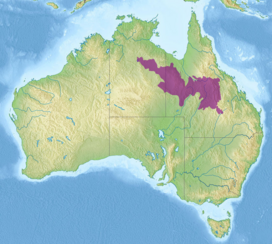| Mitchell Grass Downs | |
|---|---|
 Mitchell Grass Downs in Boulia, Queensland Mitchell Grass Downs in Boulia, Queensland | |
 Ecoregion territory (in purple) Ecoregion territory (in purple) | |
| Ecology | |
| Realm | Australasian |
| Biome | tropical and subtropical grasslands, savannas, and shrublands |
| Borders | List |
| Geography | |
| Area | 471,881 km (182,194 sq mi) |
| Country | Australia |
| States | |
| Coordinates | 22°24′S 141°36′E / 22.4°S 141.6°E / -22.4; 141.6 |
| Conservation | |
| Conservation status | Vulnerable |
| Protected | 11,486 km (2%) |
The Mitchell Grass Downs is a tropical and subtropical grasslands, savannas, and shrublands ecoregion in northeastern Australia. It is a mostly treeless grassland, characterised by Mitchell grasses (Astrebla spp.).
Location and description
The ecoregion is bounded on the north and east by tropical savanna ecoregions – the Victoria Plains tropical savanna to the northeast, the Carpentaria tropical savanna to the north, the Einasleigh Uplands savanna to the northeast, and the Brigalow tropical savanna to the east. More arid ecoregions lie to west and south – the Great Sandy-Tanami desert to the southwest, the Simpson Desert to the south, and the Eastern Australia mulga shrublands to the southeast.
The ecoregion includes three IBRA regions – Mitchell Grass Downs, Mount Isa Inlier, and Desert Uplands.
Climate
The climate is tropical and semi-arid. Average annual rainfall varies across the ecoregion, from 350 mm to 750 mm. In much of the ecoregion rainfall is seasonal, coinciding with the summer monsoon. Rainfall becomes less seasonal towards the southeast.
Flora
The vegetation consists mostly of grasses along with wildflowers and low shrubs, including Queensland bluebush (Chenopodium auricomum). There are scattered dry acacia woodlands, predominantly of gidgee (Acacia cambagei). Watercourses support woodlands of red river gum (Eucalyptus camuldulensis), coolibah (E. coolabah), and paperbark (Melaleuca spp.).
The Desert Uplands has dry woodlands of Eucalyptus populnea, E. melanophloia, and E. similis. Low open woodlands of snappy gum (Eucalyptus leucophloia), Cloncurry box (E. leucophylla), and silver box (E. pruinosa) grow in the Mount Isa Inlier.
External links
- "Mitchell Grass Downs". Terrestrial Ecoregions. World Wildlife Fund.
 Media related to Mitchell Grass Downs at Wikimedia Commons
Media related to Mitchell Grass Downs at Wikimedia Commons
References
- Dinerstein, Eric; Olson, David; et al. (June 2017). "An Ecoregion-Based Approach to Protecting Half the Terrestrial Realm". BioScience. 67 (6): 534–545. doi:10.1093/biosci/bix014. PMC 5451287. PMID 28608869.
{{cite journal}}: CS1 maint: date and year (link) Supplemental material 2 table S1b. - ^ "Mitchell Grass Downs". Terrestrial Ecoregions. World Wildlife Fund.
- "Map of Ecoregions 2017". Resolve. Retrieved 20 August 2021.
- "Mitchell Grass Downs". Digital Observatory for Protected Areas. Retrieved 20 August 2021.
- "Mitchell Grass Downs". The Encyclopedia of Earth. Retrieved 20 August 2021.
- Stanton, J. P. (James Peter); Morgan, M. G; University of New England. School of Natural Resources (1977), The rapid selection and appraisal of key and endangered sites : the Queensland case study, the University of New England School of Natural Resources, pp. 1–10, retrieved 11 February 2022